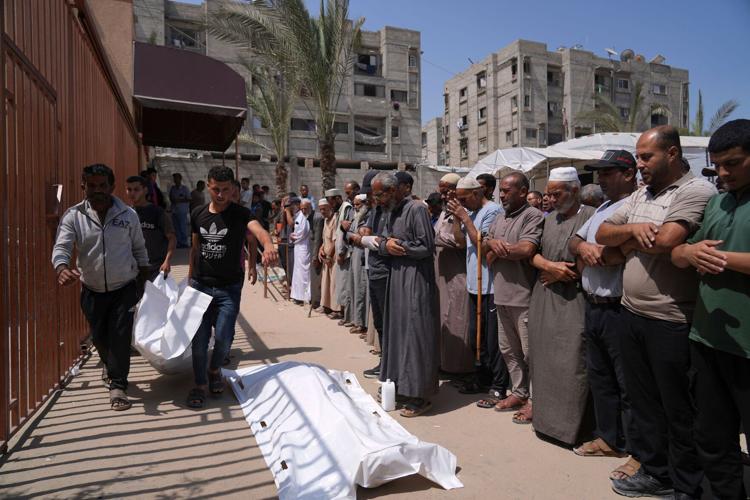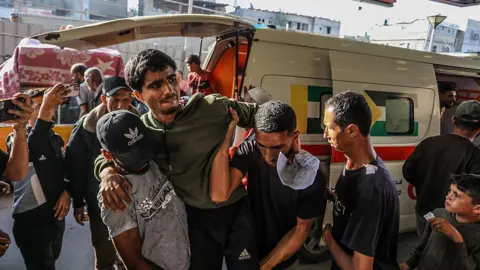RAFAH, Gaza Strip — At least three Palestinians were killed and dozens more injured by Israeli fire near a U.S.-sponsored humanitarian aid site in Rafah, according to Gaza health officials on Monday, highlighting the increasingly perilous conditions surrounding aid distribution in the war-ravaged enclave.

The fatalities occurred near an aid distribution point operated by the Gaza Humanitarian Foundation (GHF), a U.S.-based group endorsed by Israel. The Israeli military confirmed it was reviewing reports of casualties but said the incident took place about one kilometer from the GHF facility. In a statement, the military said troops operating overnight in Rafah fired warning shots “to prevent several suspects approaching them.”
Despite the reports from Gaza’s health ministry, the GHF asserted that there were no injuries or fatalities at its aid site or nearby. The group has distributed nearly six million meals since launching operations last week, bypassing traditional aid channels and drawing criticism from humanitarian organizations.
Reuters was unable to independently verify details of the incident. However, it marks the second deadly episode near the same site in as many days, deepening international concerns about the safety of civilians seeking aid. On Sunday, Palestinian and international sources reported that 31 people were killed and dozens more injured in another deadly encounter near the GHF’s Rafah facility.
The United Nations condemned the violence. U.N. Secretary-General António Guterres said he was “appalled” by reports of deaths and injuries among Palestinians attempting to access humanitarian aid and called for an independent investigation. In contrast, the Israeli military denied involvement in Sunday’s reported incident and accused Hamas of fabricating the casualty figures. The GHF echoed those claims, saying Sunday’s aid distribution proceeded without issue.
In a separate statement, the Israeli military said its forces expanded operations across Gaza in the past day, killing gunmen and destroying weapons caches and underground infrastructure. Meanwhile, Gaza’s health ministry reported that 51 Palestinians were killed and 500 others wounded by Israeli strikes over the last 24 hours.

The mounting civilian toll comes as the U.N. warns of a looming famine in Gaza. Following an 11-week blockade that severely limited aid access, nearly all of Gaza’s two million residents are now considered at high risk of starvation. Despite launching its own aid distribution network, the GHF has faced backlash from humanitarian agencies and local Palestinian groups, which argue the organization lacks transparency and violates humanitarian principles.
The Palestinian NGOs Network called for a boycott of what it termed the “U.S.-Israeli aid mechanism,” following Sunday’s bloodshed. At Nasser Hospital in Khan Younis, grief-stricken relatives gathered Monday to bury Hussam Wafi, a 37-year-old father of six killed in Sunday’s incident.
“The U.S. and Israel tell us to go collect aid, and when we do, they shoot us,” said Wafi’s brother, Ali. “They were hungry. They were going peacefully for food—some hummus or fava beans—and they died for it.”
Meanwhile, efforts to broker a temporary ceasefire between Israel and Hamas remain stalled. Both sides continue to blame each other for the failure of recent mediation efforts led by Egypt, Qatar, and the United States. A Palestinian official familiar with the negotiations said Hamas leaders were engaged in ongoing discussions with mediators in Cairo and Doha.
Israel has indicated willingness to accept a temporary truce in exchange for the release of hostages held in Gaza. However, officials insist the broader military campaign will continue until Hamas is eradicated.
The Israeli offensive began in response to the October 7, 2023, Hamas-led attack on southern Israel that killed approximately 1,200 people, mostly civilians, and resulted in the abduction of 251 hostages, according to Israeli authorities.
Since then, the conflict has devastated Gaza, with more than 54,000 Palestinians killed, according to local health officials. Much of the territory lies in ruins, and the majority of the population now resides in makeshift shelters amid worsening humanitarian conditions.



